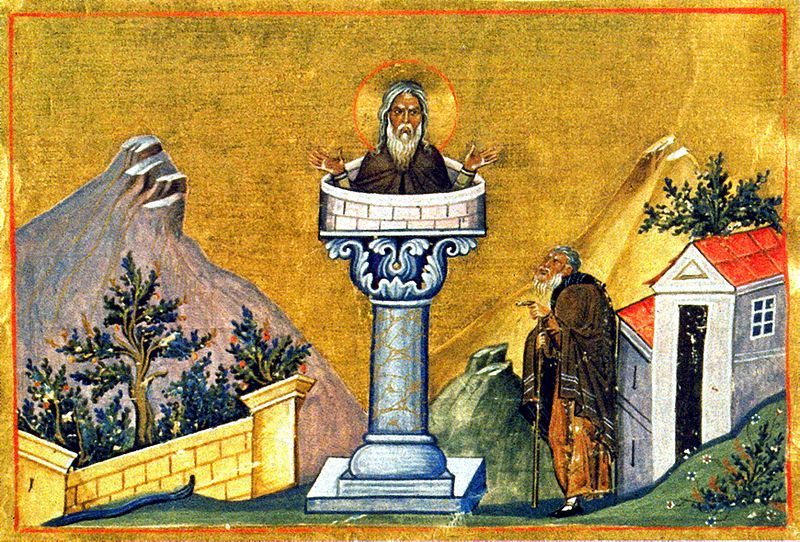Many monks and hermits go to great lengths to deny themselves of simple pleasures in order to atone their sins and pursue spiritual goals. Some live frugal lives. Some renounce meat and alcohol. Some live in seclusion. Some even go to extreme cases of self-torment such as fasting and self flagellation. And then, there are the pillar-dwellers that became very common during the early days of Christian monasticism. These type of ascetic, known as stylites, or pillar hermits, lived on top of pillars, and the one who invented this way of life was Simeon Stylites the Elder.

Simeon was born around 390 AD to a poor shepherds family in northwestern Syria, at a time when the Roman empire had been officially Christian for less than a century. Simeon developed a passion for Christianity after hearing a sermon on the Beatitudes as an early teenager. Before he was sixteen, he had abandoned the tending of his father's flocks and entered a monastery.
From the very start, Simeon gave himself up to the practice of an austerity so extreme and to all appearance so extravagant, that it caused much resentment among his fellow monks who were unable to equal his zeal. On one occasion, he passed the whole Lent without eating. When some of the monks went to check upon him in his hut, they discovered him unconscious. When he was brought back to the monastery, his rescuers were shocked to discover that his entire midsection was encased in a girdle of palm fronds, a home-made device for mortifying his flesh. The monastic authorities decided to ask Simeon to leave, claiming that his excessive ascetic efforts were incompatible with their own style of spiritual discipline.

The Church of Saint Simeon Stylites, in Aleppo, Syria. Photo: Bernard Gagnon/Wikimedia
After his ejection from the monastery, Simeon became a wandering solitary hermit, seeking always to suppress his physical desires and to liberate his spirit through impassioned ascetic practices. As Simeon’s fame grew, he attracted a large following of disciples and admirers who sought to follow his spiritual path seeking his advice, intercession with God or miraculous assistance. But the young monk wanted to escape human company, not attract it. After several failed escape attempts, Simeon found a pillar which had survived among ruins in nearby Telanissa in modern day Syria, with a platform on the top. Simeon climbed the pillar and found the solitude high up so refreshing that he refused to come down. Simeon took up a life of prayer and fasting on top of the pillar, subsisting on small rations of bread and goat milk that local boys passed up to him.
The first pillar that Simeon occupied was little more than 3 meters tall. He later moved his platform to a succession of pillars of increasing height; the last in the series reportedly more than 15 meters from the ground. At the top of the pillar was a platform, which is believed to have been about one square meter and surrounded by a baluster.
Edward Gibbon in his History of the Decline and Fall of the Roman Empire describes Simeon's life as follows:
In this last and lofty station, the Syrian Anachoret resisted the heat of thirty summers, and the cold of as many winters. Habit and exercise instructed him to maintain his dangerous situation without fear or giddiness, and successively to assume the different postures of devotion. He sometimes prayed in an erect attitude, with his outstretched arms in the figure of a cross, but his most familiar practice was that of bending his meagre skeleton from the forehead to the feet; and a curious spectator, after numbering twelve hundred and forty-four repetitions, at length desisted from the endless account. The progress of an ulcer in his thigh might shorten, but it could not disturb, this celestial life; and the patient Hermit expired, without descending from his column.
Simeon lived on top of the pillar for 37 years. After his death at the age of 68, his body was taken down and brought to Antiochia, in what is modern-day Turkey, in a large funeral procession.

Ruins of the Church of Saint Simeon with remains of his column, now topped with a boulder. Photo: Wikimedia
A few decades following Saint Simeon's death, a large monastic church occupying over 5,000 square meters was constructed in on the site where his pillar stood. The church was made up of four basilicas that emanated from the sides of a central octagon. The octagonal crossing was surmounted by a dome; at its center stood Simeon’s column. Throughout the centuries, pilgrims chipped away at the pillar and took away chunks of it as relics, leaving the pillar but only a few meters tall today.












Comments
Post a Comment